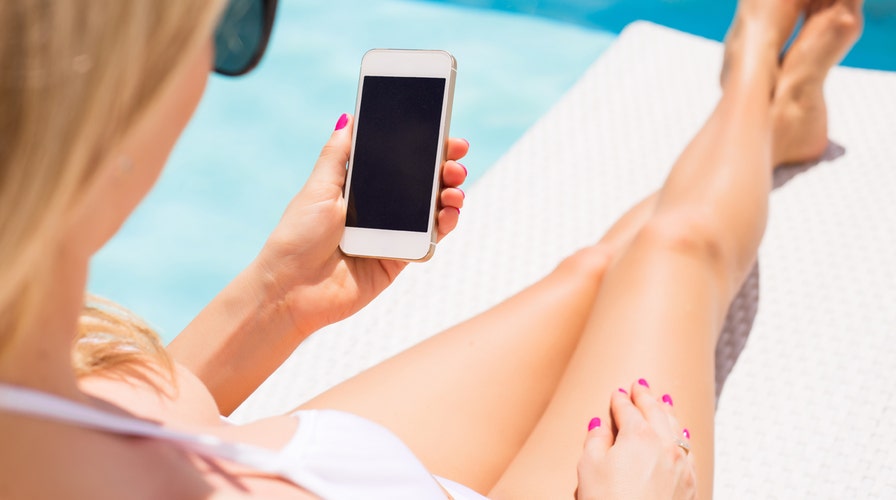Apps to help you fight off skin cancer
New smartphone applications help detect cancerous moles and warn users about dangerous UV rays
One in five Americans will develop skin cancer in their lifetime. But if it's detected early, it's almost always curable.
In today's tech-obsessed world, new smartphone applications claim they can help to detect cancerous moles and warn users about dangerous ultraviolet (UV) rays.
Dr. Whitney Bowe, a dermatologist in the New York tri-state area, said apps can help someone struggling with self-exams. Bowe normally sees patients once a year for a full-body skin check, but advises them to do self-skin exams on a monthly basis.
“For some people the self-exam can be very overwhelming, especially if they have a number of different moles, so you can envision that certain apps can be very helpful to remind the person to do their self-exam and help them keep track of their moles,” Bowe told FoxNews.com.
Mole tracking apps
Apps like Mole Mapper, developed by Oregon Health & Science University (OHSU), prompt users to take photos of their skin to help monitor the size, shape and color of their moles. Mole Mapper measures the size of a mole by comparing your photographs to a common reference object like a coin or pencil eraser. Users are asked to re-measure their moles in the app every 30 days to capture any changes that may occur over time.
“The most important thing that you’re looking for when you do a self-skin exam is a change or evolution, something that’s different about a particular mole,” Bowe said. “So some of these apps can replay images of one particular mole over time, making it easier to note whether there is indeed a change in that mole.”
Not only does the app aim to track potential skin cancers, but it was also designed to provide information for melanoma researchers at OHSU.
“They key to advancing our research is obtaining data, and lots of it. In addition, having access to data we can analyze over long periods of time— months, even years— will increase our ability to identify trends and make strides in research," Dr. Sancy Leachman, the chair of the department of dermatology in the OHSU School of Medicine and director of the OHSU Knight Cancer Institute Melanoma Research Program, told FoxNews.com.
Mole Mapper is free to download and is available for iPhones.
My Skin Pal asks users to take pictures of their moles so they can revisit the images and apply color filters to identify potential suspicious patterns. My Skin Pal will even send you reminders when a mole hasn't been scanned in a while.
It’s important to remember that these apps do not attempt to give a diagnosis. If you find any atypical moles that you’re worried about, you can share your photo history with a dermatologist in your area directly from the app. My Skin Pal is free to download and is available for iPhone and Android devices.
Bowe reiterated that the gold standard is going to your dermatologist, but sending a picture of your skin condition to a doctor will give you some initial feedback on whether or not you are in an emergency situation. However, Bowe is skeptical about any apps that use computer algorithms to tell you if a mole is suspicious or not.
“[Melanoma] is a very time-sensitive diagnosis— every single day that passes by counts. So if an app tells you ‘Hey you don’t need to worry about that mole,' and yet it’s actually an evolving melanoma, that can mean the difference between life and death,” she said.
UV monitoring apps
Exposure to UV rays from sunlight or tanning beds is one of the major causes of skin cancer. Tools like My UV Patch can play a critical role in keeping you informed on just how much sun you’re getting throughout the day.
My UV Patch, a thin sticker that looks like a tattoo, goes directly onto the skin to collect the user's UV exposure. Photosensitive dyes on the patch change color depending on sun exposure. When users apply SPF, the patch recognizes the extra protection and will readjust the reading accordingly. After snapping a picture of the patch in its companion app, the data collected from the sticker gets transferred to the app to show users their daily exposure in real-time. The app can also be set up with push reminders so you know when to re-scan the patch. My UV Patch is being launched as an educational tool and will be given away as a free gift with purchase of La Roche-Posay products on the La Roche-Posay website and amazon.com. The companion app is available on both iPhone and Android devices.
“It’s essential to know what your level of UV exposure is throughout the day, because most people think they are not being exposed, when indeed they are,” Bowe said. “Try to avoid the sun between the hours of 10am to 2pm because that’s when you’re getting the strongest UV rays.”
June, a fashionable wristband and app is another wearable option that measures sun exposure.
The jewel-inspired device can be worn as a brooch or bracelet and tracks UV intensity in real time. Based on the user’s skin type and observed habits, the app offers personalized tips on how and when to protect your skin with sunscreen, a hat or sunglasses. The app can also send out notifications when a user has reached the recommended maximum sun exposure for the day. A June bracelet costs $129 and is compatible with the iPhone.
Despite the potential benefits of apps for skin protection, no program should replace an annual skin check with a dermatologist, Bowe said.
"The doctor can look at you, take your personalized history, even palpate and feel the lesions, and look at them up close with fancy instrumentation— those are the kinds of interactions that you simply can’t replace right now with apps," she said.

